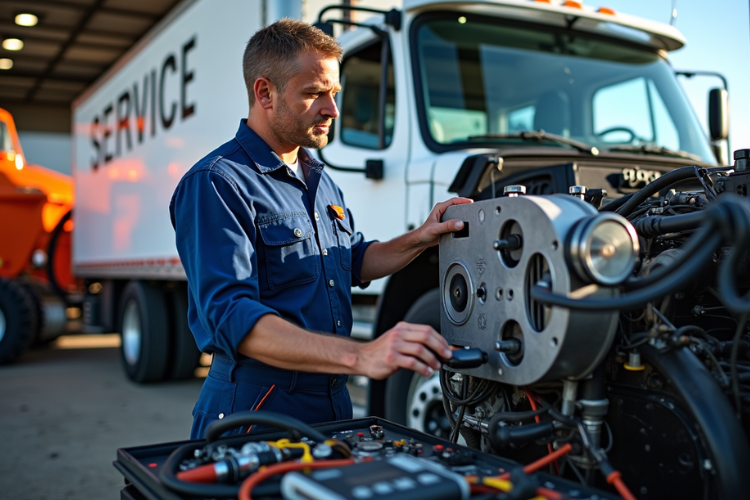Visual Support: The Game Changer for Cutting Truck Rolls in Customer Service
In the bustling world of customer support, the term "truck roll" often evokes a sense of urgency and expense. These physical visits by technicians—driving to a customer’s location to install or repair equipment—are not just logistical maneuvers; they represent a significant strain on resources, time, and carbon footprints.
With sustainability becoming an increasingly pressing concern, the need to reduce truck rolls is paramount. But how can businesses effectively tackle this challenge? The answer lies in leveraging visual support.
Understanding the Truck Roll Phenomenon

1.1 What Constitutes a Truck Roll?
Truck rolls occur under various circumstances: from installation mishaps to troubleshooting failures, these visits are often a necessary evil. However, many of these situations could be resolved remotely with the right guidance.
Common misconceptions suggest that in-person visits are always warranted. Yet, armed with visual support tools, customer service teams can guide customers through troubleshooting steps, saving time and resources.
1.2 The Financial and Environmental Impact of Truck Rolls
The costs associated with truck rolls extend beyond mere labor. Think fuel expenses, vehicle maintenance, and the hidden costs of technician downtime. Each unnecessary visit chips away at profit margins and contributes to a growing environmental concern.
According to research, reducing truck rolls not only enhances operational efficiency but also significantly lowers carbon emissions, aligning with global sustainability goals.
The Power of Visual Support

2.1 What is Visual Support?
Visual support encompasses various tools and technologies designed to offer remote assistance through visual means. This can range from video calls to augmented reality (AR) applications, enabling technicians to see exactly what the customer sees.
This immediacy transforms the troubleshooting process, allowing for real-time guidance and solutions.
2.2 Benefits of Implementing Visual Support
- Enhanced Customer Experience: Customers appreciate quick resolutions. Visual support facilitates immediate assistance, leading to higher satisfaction rates.
- Reduction in Response and Resolution Time: With remote diagnostics, the time spent on issue resolution diminishes significantly.
- Improved First-Time Fix Rates: By guiding customers through troubleshooting visually, businesses can resolve issues on the first contact, reducing the need for follow-up visits.
Strategies to Leverage Visual Support

3.1 Implementing Remote Visual Support Tools
Tools like Blitzz Remote Support are revolutionizing the way technicians interact with customers. These platforms allow service providers to assess situations before deploying their teams, diagnosing issues remotely and ensuring that truck rolls are only employed when absolutely necessary.
3.2 Utilizing Visual AI for Enhanced Diagnostics
Visual AI is a game-changer in the realm of troubleshooting. By analyzing visual data, AI can suggest solutions based on previous cases, effectively reducing the number of unnecessary truck rolls.
Companies that have integrated Visual AI into their customer support systems have reported significant improvements in operational efficiency and customer satisfaction.
3.3 Augmented Reality (AR) in Customer Support
Imagine a scenario where a technician can virtually guide a customer through fixing a problem using AR. This technology allows for interactive, visual diagnostics that not only improve first-time fix rates but also create a more engaging customer experience.
Businesses leveraging AR solutions are witnessing a marked decrease in the need for physical site visits.
Financial and Operational Considerations

4.1 Tiered Pricing Models for Remote Support
To encourage the adoption of remote support solutions, businesses should consider offering tiered pricing models. By providing various levels of service—ranging from basic troubleshooting to extensive visual support—companies can cater to different customer needs and budgets.
This approach not only makes remote support financially appealing but also promotes its widespread use.
4.2 Integration with Existing Systems
Seamless integration of remote visual support tools with existing customer management systems is crucial. When these technologies work in harmony, they enhance operational efficiency and ensure that customer service representatives have all the necessary information at their fingertips. This integration minimizes disruption and maximizes productivity.
Real-World Examples and Case Studies

5.1 Companies Leading the Charge
Several companies are setting the standard for reducing truck rolls through innovative visual support solutions. For instance, a major telecommunications provider utilized remote visual support to significantly cut down unnecessary site visits, ultimately enhancing their service delivery.
Their proactive approach led to a notable increase in customer satisfaction scores and operational efficiency.
5.2 Metrics to Measure Success
To gauge the effectiveness of visual support tools, businesses should implement key performance indicators (KPIs) such as:
- Reduction in truck rolls
- Customer satisfaction ratings
- Time to resolution
By closely monitoring these metrics, companies can refine their strategies and maximize the benefits of visual support.
Conclusion
In a world where efficiency, cost reduction, and environmental sustainability are paramount, leveraging visual support to reduce truck rolls is not just a strategic advantage; it’s a necessity.
By implementing remote visual support tools, utilizing AI, and embracing AR technology, businesses can transform their customer service operations, enhancing both the customer experience and their bottom line.
Ready to elevate your customer support game? Experience the power of visual support today!
FAQs
What are the common issues that lead to unnecessary truck rolls?
Truck rolls often occur due to miscommunication, lack of information, or inadequate troubleshooting prior to scheduling a service visit. Common issues include unclear customer descriptions of problems, insufficient diagnostic tools, and failure to provide remote support options.
By utilizing visual support tools, businesses can diagnose issues remotely, reducing the need for on-site visits.
How quickly can businesses expect to see results from visual support implementation?
The timeline for seeing results from visual support implementation can vary, but many businesses report noticeable improvements within a few weeks to a few months.
Factors influencing this timeline include the complexity of the tools adopted, staff training, and integration with existing systems. Early indicators of success often include reduced truck rolls and improved customer satisfaction.
What types of training are necessary for staff to effectively use visual support tools?
Staff training for visual support tools should focus on the technical aspects of using the software, effective communication techniques for remote interactions, and troubleshooting skills.
Training sessions can include hands-on practice, virtual workshops, and access to user manuals. Continuous support and updates on new features are also essential for maximizing the benefits of these tools.
How can businesses measure the effectiveness of visual support tools?
Businesses can measure the effectiveness of visual support tools through key performance indicators (KPIs) such as the reduction in truck rolls, average response and resolution times, first-time fix rates, and customer satisfaction scores.
Regularly analyzing these metrics helps identify areas for improvement and ensures that visual support strategies are meeting their objectives.
What are some examples of industries that benefit from visual support in reducing truck rolls?
Industries such as telecommunications, home services, healthcare, and field service management have seen significant benefits from implementing visual support.
These sectors often face complex technical issues that can be addressed remotely, allowing for quick resolutions and minimizing the need for on-site visits, thereby improving operational efficiency and customer satisfaction.
.png?width=120&height=55&name=Blitzz-Logo-right%20white%20eyes%20-%20not%20transparent%20(3).png)


